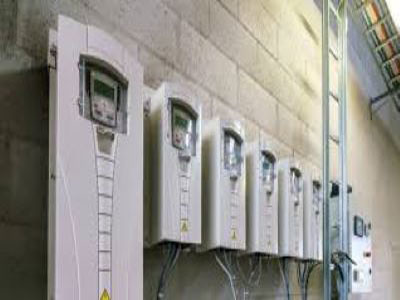Key Takeaway
A Variable Frequency Drive (VFD) offers several benefits for industrial applications. It regulates the start and stop cycles of motors, reducing wear and tear on machine components. This ensures efficient operation and extends the lifespan of machinery. VFDs also provide energy savings by adjusting motor speed to match the required load, reducing electricity consumption. Additionally, features like anti-shock minimize rapid torque increases, stabilizing loads and protecting equipment. VFDs improve process control, enhance system reliability, and lower maintenance costs. Overall, VFDs optimize performance, increase efficiency, and contribute to significant cost savings.
Energy Efficiency and Cost Savings
One of the primary benefits of VFDs is energy efficiency. By controlling the motor speed, VFDs ensure that motors only consume the energy required for the task, rather than running at full speed continuously. This optimization can lead to significant energy savings, often reducing consumption by up to 50%. Lower energy usage translates directly into cost savings, making operations more economical. Additionally, many industries receive incentives or rebates for implementing energy-efficient technologies, further enhancing the financial benefits. In today’s competitive market, these savings can give companies a crucial edge, making VFDs a wise investment.

Enhanced Motor Control and Performance
VFDs are game-changers in motor control, enhancing both performance and efficiency. They allow precise speed adjustments to match application needs, ensuring smooth operation and minimizing wear on machinery. This precision is vital in manufacturing, where maintaining exact speeds is crucial for high-quality production. For instance, when producing delicate materials, VFDs ensure consistency and quality by controlling motor speeds accurately.
Additionally, VFDs provide a soft start for motors, gradually ramping up speed. This prevents sudden current surges that could damage components and cause downtime. Imagine starting a motor without a VFD—it’s like flooring the gas pedal in a car; the sudden jolt can be damaging. By avoiding these surges, VFDs contribute to longer equipment life and reduced maintenance costs.
Enhanced control also means more reliable operations. With VFDs, you can expect fewer interruptions and more consistent performance, leading to higher productivity and lower operational costs. This reliability is a cornerstone of our commitment to quality and efficiency.
You May Like to Read
Increased Equipment Lifespan
When it comes to increasing the lifespan of industrial equipment, Variable Frequency Drives (VFDs) play a pivotal role. VFDs control motor speed, which enhances performance and reduces wear and tear. By adjusting the speed, VFDs minimize mechanical and electrical stress on motors. This reduction in stress is crucial for preventing overheating and other issues that can lead to early failures.
A key advantage of VFDs is their ability to gradually ramp up and down motor speeds. This gradual change reduces mechanical shock, benefiting components like bearings and gears significantly. As a result, the equipment experiences less strain, leading to fewer breakdowns and a longer operational life.
For industries that rely heavily on machinery, the extended lifespan of equipment means fewer replacements and less frequent repairs. This directly translates to lower maintenance costs and improved operational efficiency. Over time, these benefits accumulate, resulting in substantial long-term savings.
Reduced Environmental Impact
Variable Frequency Drives (VFDs) play a pivotal role in promoting environmental sustainability. These devices significantly cut energy consumption and reduce greenhouse gas emissions, aligning with global efforts towards greener industrial practices. As industries face increasing pressure to adopt sustainable solutions, VFDs emerge as a practical answer to these demands.
By fine-tuning energy usage, VFDs help minimize the carbon footprint of industrial operations. This is especially crucial as companies strive to meet stringent environmental regulations and enhance their eco-friendly reputation. The energy savings from VFDs are not just minor improvements but can be substantial, particularly when applied across large-scale operations or multiple facilities. This scalability makes VFDs a cornerstone in achieving overall environmental sustainability.
Moreover, industries adopting VFDs signal their commitment to sustainability, which can bolster their market image. This commitment is not just about compliance but also about leading the way in sustainable practices. For newly joined engineers, understanding the impact of VFDs on the environment highlights their importance in modern industrial applications.
Improved Process Control and Flexibility
In today’s fast-paced industrial landscape, process control and flexibility are paramount. Variable Frequency Drives (VFDs) provide a significant advantage in this regard. They allow precise motor speed adjustments, enabling operators to fine-tune processes to meet specific requirements. This flexibility is essential for improving efficiency and productivity.
Consider the manufacturing industry, where different stages of production require varying speeds. VFDs make it easy to adjust these speeds on the fly, ensuring optimal performance at each stage. For instance, during the assembly phase, slower speeds might be necessary for accuracy, while faster speeds are suitable for packaging.
Additionally, VFDs integrate seamlessly with other automation systems, providing comprehensive control over entire production lines. This integration ensures that every part of the process is synchronized, reducing downtime and enhancing overall productivity.
Imagine explaining this to a newly joined engineer: “With VFDs, you can easily adapt to changing production needs. If a specific task demands a slower speed for precision, you can adjust it in real-time without halting the entire process. This capability not only boosts efficiency but also ensures product quality.”
Conclusion
In conclusion, VFDs offer a wide range of benefits that make them indispensable in industrial applications. They provide significant energy efficiency and cost savings, enhance motor control and performance, increase equipment lifespan, and reduce environmental impact. Moreover, VFDs offer improved process control and flexibility, which are essential for modern industries. For newly joined engineers, understanding the advantages of VFDs is crucial for optimizing operations and contributing to sustainable, efficient, and high-performing industrial environments. Embracing VFD technology is not just a technical decision but a strategic move towards a more efficient and sustainable future.
